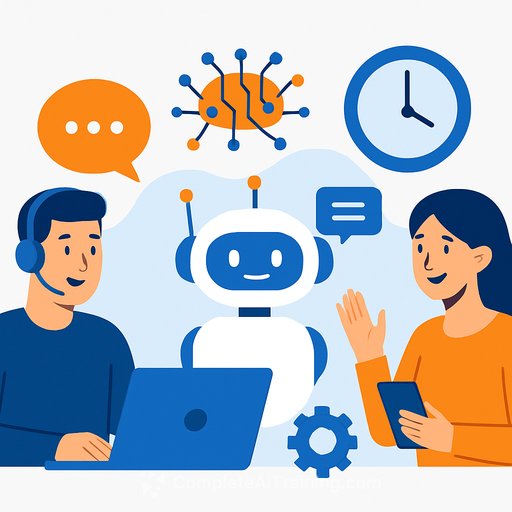From Six Hours to Six Minutes: How Smartsheet Rebuilt Support with AI Agents
Fast resolution isn't a luxury in support - it's the trust contract. Smartsheet cut resolution time from hours to minutes by putting AI agents at the core of its help desk. The result: instant answers for 13 million users, no ticket queues, and happier customers.
In a conversation on theCUBE at Dreamforce, James Watson, vice president of customer excellence at Smartsheet, explained how the team made the shift using Salesforce's Agentforce. "We had to put AI into this to be able to help us do those complex administrative tasks so much faster," he said. "We use AI on the back side, we call it the back door, and we do all the research, we generate a response. All of that takes six minutes."
What Actually Changed Under the Hood
Smartsheet's agent doesn't just respond faster - it does the homework for the agent. It pulls from internal systems, runs the checks, drafts the response, and pushes the fix. The "back door" does the work a human would do, just in a fraction of the time.
The breakthrough came from training on unstructured data. "Structured data is very easy … but the unstructured data, that's all of the cases that we've done in the past," Watson said. They fed Agentforce solved cases, knowledge content, and product language so the agent could understand Smartsheet's terminology and patterns. Every new case improves the next one.
No Tickets, Fewer Waits, Clear Ownership
Smartsheet's agents handle common help desk and billing issues without creating tickets. If the bot can resolve it, it does - and if it can't, it hands off with full context. That keeps humans focused on edge cases and complex customer scenarios, not chasing down routine updates.
From Reactive Fixes to Account Growth
Closing the case is step one. Smartsheet then asks, "Now that we have resolved your issue, what can we do next?" That shift opens the door to smarter follow-ups, account expansion, and solution-wide recommendations - without feeling salesy.
How to Replicate This in Your Support Org
- Define the "six-minute" path: List top repetitive cases (billing changes, access issues, plan questions) and map the exact steps a human takes to resolve them.
- Centralize data: Pull structured data (billing, entitlements, product settings) and unstructured data (past cases, macros, knowledge articles) into one searchable layer.
- Teach your language: Build a glossary for product terms, SKUs, policies, and intents so the agent doesn't guess.
- Automate the back door: Let the agent research, verify in systems of record, and draft responses. Gate final actions behind clear rules.
- Escalate cleanly: When confidence is low, hand off with a summary, logs, and proposed next steps. No dead ends.
- Protect customers: Mask PII, log actions, and put approvals on anything that touches money, data, or security.
- Ship small, learn fast: Start with one or two workflows, measure hard, then expand.
Metrics That Matter
- Time to resolution (target minutes for known workflows)
- First contact resolution and containment rate (handled end-to-end by the agent)
- Deflection rate (no-ticket resolutions for common issues)
- CSAT with verbatims (do customers trust the answers?)
- Escalation rate and rework (how often humans fix AI output)
- Billing and refund accuracy (zero tolerance for errors here)
- Content freshness (age of referenced articles in resolved cases)
Operational Guardrails That Keep You Safe
- Scope: List exactly what the agent can and cannot do (e.g., change plan vs. cancel account).
- Confidence thresholds: Require human review below a score. Log every override.
- Immutable logs: Keep a full audit of prompts, context, actions, and outputs.
- Change control: Tie agent behavior to versioned playbooks and policies, not tribal knowledge.
- Content lifecycle: Archive stale articles, auto-flag contradictions, and notify owners to update.
A Practical Rollout Sequence
- Shadow mode: Let the agent propose answers while humans handle the case. Compare outputs.
- Low-risk workflows first: Password resets, billing address updates, invoice copies, entitlement checks.
- Human-in-the-loop: Require approval for refunds, escalations, and security actions.
- Quality reviews: Sample daily. Track false positives and fix root causes (content, data, or rules).
- Expand by policy: Once an intent hits target accuracy for two weeks, widen scope.
Why This Works for Support Leaders
Speed restores trust and reduces volume. When the "back door" does the research, your team stops juggling tabs and starts solving problems. That compounds into better CSAT, leaner operations, and more thoughtful conversations with customers.
Resources
- Salesforce Agentforce overview - for teams exploring agent-driven support.
- AI courses by job - upskill your support org on AI, automation, and quality review.
Six minutes isn't a gimmick. It's what happens when you let AI handle the grunt work and keep humans where judgment matters most.
Your membership also unlocks:






